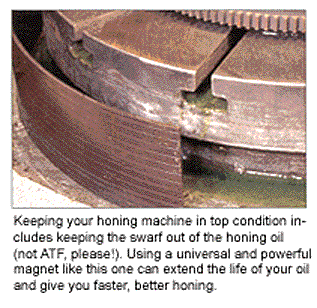Let’s start with one of the main ingredients of honing: the honing oil. Automotive type transmission fluid is NOT honing oil. Period! Don’t let me catch you using tranny fluid in your honing machine! Honing oils are not all alike either. Always use the highest quality honing oil from a supplier you can trust.
It is essential that you keep your honing oil clean from debris as well as try to minimize the actual content of swarf (the combination of honing oil, broken down honing stone abrasive and severed material you are honing).

Your first line of defense against swarf entering your filters is honing filter paper. This filter paper comes in a variety of sizes and can be easily cut to fit your machine.
Your next step is to replace your filter. Most machines have a cartridge-type filter while some use a spin-on oil filter like you have on your car’s engine. These filters will clog and need to be changed on a regular basis.
If your machine doesn’t have a filter, you can always rig one yourself. I saw a shop that had incorporated a remote-type spin-on oil filter from an automotive application and put it in line with the coolant pump. However, keep in mind that an automotive oil filter might be too fine to flow your honing oil properly. Keep experimenting until you find one to suits your needs.
I recommend adding a magnet to the equation to remove the metal particles from the honing oil. Something as simple as a horseshoe magnet – or better yet, a magnetic strip – will greatly improve the removal of metal from your honing oil and prolong the oil life, resulting in faster, honing with less stone loading.
Okay, let’s take a look at honing stones.
Stones are made from a variety of abrasive types, designed for the material you are honing. They are designed to break down and, if used properly, they should wear evenly throughout their life. However at times they will become loaded, clogged or glazed over. You can use a special diamond dresser or you can use one honing stone against another to unload the pores of the grain to make them more free cutting. In the event they become worn unevenly you must re-true them with a hardened truing sleeve.
Truing sleeves are readily available for 1? to 6? diameters, and every shop should have one for the 3-1/2? to 4? range. You may find that you’ll need to fabricate your own for the larger diameters. Clamp the truing sleeve into your fixture and expand your stones to work the taper out of your honing stones. It sometimes will take a while, but it will be worth the effort to save that set of honing stones. Never use cleaning solvent to clean your honing stones: solvent will attack the bond of the stone making the bond harder and affecting the result of the stone’s finish.
Once in a while or at least twice a year you should drain out all of your honing oil and scrape out the goo that forms over time. Use a degreaser to thoroughly clean the entire reservoir of your machine. Replace your filters and add new, fresh honing oil.
Also, look over your machine to ensure any grease zerks are greased. Oil the traversing bar that allows the left and right movement of the honing head. Some of these machines’ hone heads are direct-drive with a gearbox and others are belt driven. For the gearbox unit, change the fluid according to the manufacturer; for the belt-driven machine, clean the belts and pulleys and adjust the belt tension according to the manufacturer’s recommendations. Look at the cover of your drive motor and fan, and clean if necessary.
Wipe down your dial bore gauge and make sure it is calibrated accurately. Spray electrical contact cleaner into the spindle movement of your dial indicator. This will also flush out the indicator so it moves freely. Another tip is to rotate the carbide contact balls and contact centralizer rings. Always store your dial bore gauge back in its case or in a drawer when not in use.
Remember honing is the final machining operation prior to installing the pistons into the cylinders. If your machine is clean, accurate and always tuned up, your end result will be what you wish it be. Remember we are here to hone not moan!
Dave Monyhan is national sales manager with Goodson Shop Supplies, located in Winona, MN. [email protected]













